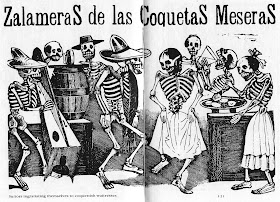
There is a brief but concise introduction to the life and work of
Posada in the book together with comments by Diego Rivera, Jose Clemente
Orozco and Andre Breton - all of which were very influenced by his work.
Posada, as chief artist of a publishing house, illustrated thousands of stories, legends, school books, card games as well as commercial advertisements and posters for bull fights, theatre and circus performances. He also produced work for Mexican popular ballads ("Corridos") and didactic poems ("Ejemplos").
In addition, his prints documented the events leading up to the Mexican Revolution of 1910, recording politics, morals and the social unrest of that period. The caricatures below could well be used to describe some of today's capitalists, bankers and other members from the establishment!






























